SCI论文模板
SCI论文写作模板(葵花宝典)
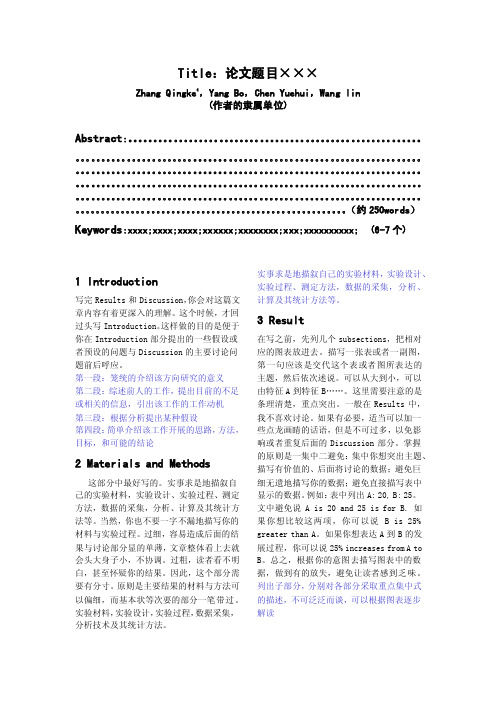
Title:论文题目×××Zhang Qingke1,Yang Bo,Chen Yuehui,Wang lin(作者的隶属单位)Abstract:。
(约250words)Keywords:xxxx;xxxx;xxxx;xxxxxx;xxxxxxxx;xxx;xxxxxxxxxx; (6-7个)1 Introduction写完Results和Discussion,你会对这篇文章内容有着更深入的理解。
这个时候,才回过头写Introduction。
这样做的目的是便于你在Introduction部分提出的一些假设或者预设的问题与Discussion的主要讨论问题前后呼应。
第一段:笼统的介绍该方向研究的意义第二段:综述前人的工作,提出目前的不足或相关的信息,引出该工作的工作动机第三段:根据分析提出某种假设第四段:简单介绍该工作开展的思路,方法,目标,和可能的结论2 Materials and Methods这部分中最好写的。
实事求是地描叙自己的实验材料,实验设计、实验过程、测定方法,数据的采集,分析、计算及其统计方法等。
当然,你也不要一字不漏地描写你的材料与实验过程。
过细,容易造成后面的结果与讨论部分显的单薄,文章整体看上去就会头大身子小,不协调。
过粗,读者看不明白,甚至怀疑你的结果。
因此,这个部分需要有分寸。
原则是主要结果的材料与方法可以偏细,而基本状等次要的部分一笔带过。
实验材料,实验设计,实验过程,数据采集,分析技术及其统计方法。
实事求是地描叙自己的实验材料,实验设计、实验过程、测定方法,数据的采集,分析、计算及其统计方法等。
3 Result在写之前,先列几个subsections,把相对应的图表放进去。
描写一张表或者一副图,第一句应该是交代这个表或者图所表达的主题,然后依次述说。
可以从大到小,可以由特征A到特征B……。
这里需要注意的是条理清楚,重点突出。
一般在Results中,我不喜欢讨论。
sci论文格式模板

sci论文格式模板篇一:优秀SCI论文结构范例优秀SCI论文结构范例1、Abstract——对自己工作及其贡献的总结:a)阐述问题;b)说明自己的解决方案和结果。
2、Introduction——背景,以及文章的大纲:a)题X是重要的;b)前人的工作A、B曾经研究过这个问题;c)A、B有一些缺陷;d)我们提出了方法D;e)D的基本特征,和A、B进行比较;f)实验证明D比A、B优越;g)文章的基本结构,大纲。
3、PreviousWork——说明自己与前人的不同:a)将历史上前人的工作分成类别;b)对每项重要的历史工作进行简短的回顾(一到几句),注意要回顾正确,抓住要点,避免歧义;c)和自己提出的工作进行比较;d)不要忽略前人的重要工作,要公正评价前人的工作,不要过于苛刻;e)强调自己的工作和前人工作的不同,最好举出各自适用例子。
4、OurWork——描述自己的工作,可分成多个部分:a)从读者角度阐明定义和表示法;b)提供算法的伪码,图解和相应解释;c)用设问的方式回答读者可能提出的潜在问题;d)复杂的冗长的证明和细节可以放在附录中,这里关键是把问题阐述清楚;e)特例和例外应该在脚注中给予说明。
5、Experiments——验证提出的方法和思路:a)合理地设计实验(简洁的实验和详尽的实验步骤)b)必要的比较,突出科学性;c)讨论,说明结果的意义;d)给出结论。
6、Conclusion——总结、前景及结文:a)快速简短的总结;b)未来工作的展望;c)结束全文。
7、References——对相关重要背景文献全面引用:a)选择引文(众所周知的结论不必引用,其他人的工作要引用);b)与前文保持一致。
8、Others——致谢、附录、脚注。
篇二:SCI论文的五种类型SCI论文的五种类型来源:医学论文发表——达晋医学编译我们要投SCI期刊,首先当然先要了解SCI期刊接受SCI 论文的类型了,由于我国SCI论文的现状使得很多作者不是很清楚SCI期刊接受文章的类型,那么接下来达晋医学编译小编给大家说说期刊接受的五大类型。
sci 投稿cover letter写作模板

sci 投稿cover letter写作模板尊敬的SCI杂志编辑:
我谨提交我研究团队的最新论文,题目为《XXX》。
我们深信这篇论文将为贵刊的读者带来新的视角和启发,希望能够得到您的审阅和考虑。
我们的研究主要围绕XXX展开,经过长时间的实验和数据分析,我们得出了令人振奋的结果。
通过本研究,我们不仅深化了对XXX的理解,同时也为相关领域的未来研究提供了有益的参考。
我们选择将这篇论文提交给贵刊,是因为我们深知贵刊在该领域的权威和影响力。
我们期待着能够借助贵刊的平台,与广大同行分享我们的研究成果,并为学术界的发展贡献自己的力量。
在此,我代表全体作者感谢您对我们论文的重视和关注。
我们将非常乐意听取您的意见和建议,希望能够与您携手共同推动学术研究的进步。
再次感谢您抽出时间来审阅我们的论文,期待早日收到您的回复。
谢谢!
此致
作者:XXX
XXX大学
日期:XXXX年XX月XX日。
cover lettersci写作模板

cover lettersci写作模板在学术和科研领域,SCI(科学引文索引)论文的发表是展示研究成果和学术水平的重要方式。
而在投稿过程中,一封专业、规范的Cover Letter能够给期刊编辑留下良好的第一印象,提高论文被录用的可能性。
本文为您提供一份实用的Cover Letter SCI写作模板,助您顺利发表学术论文。
[您的姓名][您的职位/学历][您的单位/学校][您的地址][您的邮箱][您的电话][日期][期刊名称][期刊地址]尊敬的[期刊名称]编辑:您好!我代表我的研究团队,向您提交一篇题为“[论文标题]”的研究论文,希望能在贵刊发表。
以下是我们论文的主要创新点和亮点:1.[创新点1]2.[创新点2]3.[创新点3]我们相信,这篇论文的研究成果将对[相关领域]产生积极影响,为后续研究提供新的思路和方向。
在此,我们诚挚地邀请贵刊的同行专家对这篇论文进行审阅。
以下是我们论文的简要介绍:[论文摘要或研究背景]根据贵刊的投稿要求,我们已确保论文格式符合规定,并按照期刊的审稿流程进行了认真修改。
此外,我们承诺论文未在其他期刊或会议投稿,不存在一稿多投现象。
我们深知贵刊在学术界的重要地位,以及严谨的审稿流程。
因此,我们希望能得到贵刊专家的宝贵意见和建议,以进一步提高论文的质量。
在此,我们感谢贵刊在审稿过程中所付出的辛勤努力。
如有需要,请随时通过以下方式与我们联系:[您的邮箱][您的电话]再次感谢您对这篇论文的关注和支持。
期待您的回复,祝好!顺祝商祺![您的姓名]附件:[论文全文]结束语:请根据您的实际情况,修改和完善这份Cover Letter模板,使其更加符合您的论文和投稿需求。
在撰写过程中,注意保持礼貌、简洁和专业性,以提高论文被录用的概率。
sci附录格式范例

sci附录格式范例1.引言1.1 概述在SCI论文中,概述部分是文章的开篇部分,用于引导读者了解研究的背景和目的。
概述将简要介绍研究问题、研究动机以及该研究的重要性。
以下是概述部分的一般内容模板,供参考:概述在科学研究领域中,围绕xxx问题的研究一直备受关注。
随着科技发展和人类社会的进步,xxx问题在xxx领域中扮演着重要的角色。
然而,迄今为止,对于xxx问题的深入研究仍然存在各种挑战和未解之谜。
因此,本文的目的是通过对xxx问题的深入探索,以期揭示其内在机理并提出可能的解决方案。
通过对xxx问题的系统分析与研究,将有助于拓宽我们对xxx的认知,并为未来相关领域的研究提供有益的参考。
为了实现这一目标,我们将着重讨论以下方面:首先,我们将回顾历史上对于xxx问题的研究进展,并总结已有研究的不足之处。
通过对过去研究的回顾,我们可以更好地理解研究问题的重要性和复杂性。
其次,我们将详细介绍本文的方法和实验设计。
我们将采用xxx方法和技术来解决xxx问题,并结合大规模数据和有力的实验证据进行分析。
通过严格的实施实验和科学的数据分析,我们期望能够得出准确可靠的结论。
最后,我们将对本文的结构进行简要概述。
本文将分为以下几个部分:第二部分将介绍xxx问题的背景及其相关研究。
第三部分将详细介绍研究方法和实验设计。
第四部分将展示实验结果和数据分析。
最后,第五部分将对实验结果进行讨论,并提出未来的研究展望。
通过对xxx问题的深入研究,我们期望能够为相关领域的学者和研究人员提供更多的见解和启发,并为xxx问题的解决做出积极的贡献。
以上是概述部分的内容。
根据具体研究内容和论文结构的需要,您可以对模板进行适当修改和调整,以使其更符合您的研究内容和写作风格。
1.2 文章结构文章结构是指文章的整体框架和组织方式,在写作过程中对整篇文章进行了合理的分章节和段落,使读者更易于理解和阅读。
本文将按照以下结构进行论述:引言部分、正文部分和结论部分。
sci pre-submission 模板
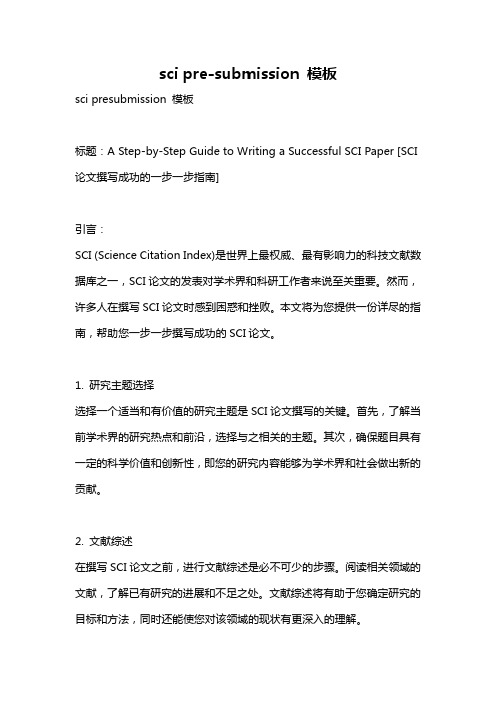
sci pre-submission 模板sci presubmission 模板标题:A Step-by-Step Guide to Writing a Successful SCI Paper [SCI 论文撰写成功的一步一步指南]引言:SCI (Science Citation Index)是世界上最权威、最有影响力的科技文献数据库之一,SCI论文的发表对学术界和科研工作者来说至关重要。
然而,许多人在撰写SCI论文时感到困惑和挫败。
本文将为您提供一份详尽的指南,帮助您一步一步撰写成功的SCI论文。
1. 研究主题选择选择一个适当和有价值的研究主题是SCI论文撰写的关键。
首先,了解当前学术界的研究热点和前沿,选择与之相关的主题。
其次,确保题目具有一定的科学价值和创新性,即您的研究内容能够为学术界和社会做出新的贡献。
2. 文献综述在撰写SCI论文之前,进行文献综述是必不可少的步骤。
阅读相关领域的文献,了解已有研究的进展和不足之处。
文献综述将有助于您确定研究的目标和方法,同时还能使您对该领域的现状有更深入的理解。
3. 研究设计和实验根据您的研究目标,设计合适的实验方案。
确定要使用的材料、方法和研究过程。
确保您的实验设计能够合理、可靠地回答您的研究问题,并且结果具有统计学意义。
4. 数据收集和分析在实验过程中,收集相关数据,并进行适当的数据分析。
选择适当的统计方法,确保您的数据分析结果能够支持您的研究结论和假设。
同时,保持数据的准确性和可重复性,以便其他研究者可以验证您的结果。
5. 结果和讨论根据数据分析的结果,撰写SCI论文的结果和讨论部分。
确保结果的准确性和清晰度,同时对研究结果进行详尽的解释和分析。
讨论部分应对您的研究目标进行细致的说明,并与已有的文献进行比较和讨论。
6. 引言和方法撰写SCI论文的引言和方法部分。
引言部分应介绍您的研究背景、目的和意义。
方法部分应详细描述您的实验设计、材料和方法步骤,以及数据分析方法。
sci论文格式
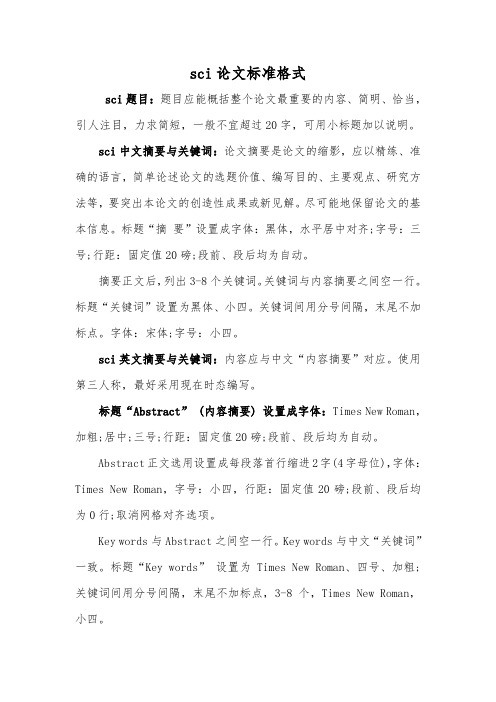
sci论文标准格式sci题目:题目应能概括整个论文最重要的内容、简明、恰当,引人注目,力求简短,一般不宜超过20字,可用小标题加以说明。
sci中文摘要与关键词:论文摘要是论文的缩影,应以精练、准确的语言,简单论述论文的选题价值、编写目的、主要观点、研究方法等,要突出本论文的创造性成果或新见解。
尽可能地保留论文的基本信息。
标题“摘要”设置成字体:黑体,水平居中对齐;字号:三号;行距:固定值20磅;段前、段后均为自动。
摘要正文后,列出3-8个关键词。
关键词与内容摘要之间空一行。
标题“关键词”设置为黑体、小四。
关键词间用分号间隔,末尾不加标点。
字体:宋体;字号:小四。
sci英文摘要与关键词:内容应与中文“内容摘要”对应。
使用第三人称,最好采用现在时态编写。
标题“Abstract” (内容摘要) 设置成字体:Times New Roman,加粗;居中;三号;行距:固定值20磅;段前、段后均为自动。
Abstract正文选用设置成每段落首行缩进2字(4字母位),字体:Times New Roman,字号:小四,行距:固定值20磅;段前、段后均为0行;取消网格对齐选项。
Key words与Abstract之间空一行。
Key words与中文“关键词”一致。
标题“Key words”设置为Times New Roman、四号、加粗;关键词间用分号间隔,末尾不加标点,3-8个,Times New Roman,小四。
sci论文目录:标题“目录”设置成字体:黑体,居中;字号:三号;行距:1.5倍行距;段前、段后均为自动;目录结构为25磅行距,两端对齐;一级标题设置为四号字,黑体;二级标题设置为小四,宋体;目录所含正文结构一般列至二级标题即可。
所含内容摘要页可选标为罗马字符页码(如I,II……)标注;正文须重新以阿拉数字设起始页(如1,2……)标注。
sci论文序言(导论):内容为本研究领域的国内外现状,本论文所要解决的问题,该研究工作在经济建设、科技进步和社会发展等基本方面的应用价值与理论意义。
SCI论文发表格式模板[Word文档]
![SCI论文发表格式模板[Word文档]](https://img.taocdn.com/s3/m/ca8fc0f90875f46527d3240c844769eae009a361.png)
SCI论文发表格式模板本文档格式为WORD,感谢你的阅读。
最新最全的学术论文期刊文献年终总结年终报告工作总结个人总结述职报告实习报告单位总结演讲稿SCI论文发表格式模板目前我国科技界对SCI论文概念模式,小部分研究者误认为SCI是一本期刊,而由于南京大学率先引用并愈来愈成为各大高校和科研机构学术评价和奖惩的一类刊物,以下是SCI格式模板,供大家阅读查看。
AbstractAbstract:整体要求简练,言简意赅,因为绝大部分journal对Abstract都有字数限制,一般150~250 words。
先简单描述一下自己工作的前沿背景,几句话,然后引出自己的实验(“In this paper….”; “Herein...” or “Here, we…”),主要陈述实验结果,可稍带提一下所用到的重要方法的名称,然后说明你的结果的意义“There data suggest….”;最后总结拔高“In a word….”or “in summary…..”。
摘要中谓语动词的时态基本上分一般现在时和一般过去时两种。
由于科研通常采用一般现在时,所附摘要自然也多用一般现在时态。
(1) 叙述研究方法和目的时,使用一般现在时态。
A. This article sets out four of the main misconcepts, discusses why they have arisen, and why they can be so described.B. To answer this, the author explores two new algorithms:a.keep in the cache documents that take the longest to retrieve; and e a hybrid of several factors…(2)推导研究结果时用一般现在时态。
A.The results show that the period of induction and the patent period of stressor can be initially confirmed by the electrical conductivity of medium and the variability of soluble protein in tomato.B.A method for stiffness calculation undervertical load is devised.(3) 回顾研究过程时,用一般过去时态。
【sci论文格式模板】sci期刊论文格式模板
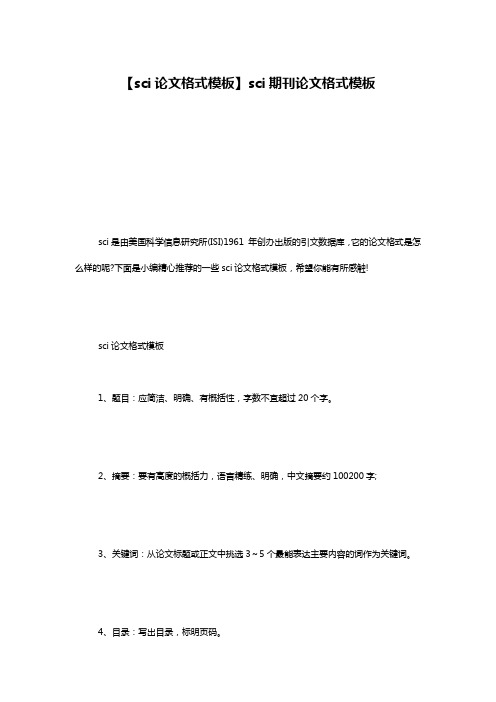
【sci论文格式模板】sci期刊论文格式模板sci是由美国科学信息研究所(ISI)1961 年创办出版的引文数据库,它的论文格式是怎么样的呢?下面是小编精心推荐的一些sci论文格式模板,希望你能有所感触!sci论文格式模板1、题目:应简洁、明确、有概括性,字数不宜超过20个字。
2、摘要:要有高度的概括力,语言精练、明确,中文摘要约100200字;3、关键词:从论文标题或正文中挑选3~5个最能表达主要内容的词作为关键词。
4、目录:写出目录,标明页码。
5、正文:论文正文字数一般应在3000字以上。
论文正文:包括前言、本论、结论三个部分。
前言(引言)是论文的开头部分,主要说明论文写作的目的、现实意义、对所研究问题的认识,并提出论文的中心论点等。
前言要写得简明扼要,篇幅不要太长。
本论是论文的主体,包括研究内容与方法、实验材料、实验结果与分析(讨论)等。
在本部分要运用各方面的研究方法和实验结果,分析问题,论证观点,尽量反映出自己的科研能力和学术水平。
结论是论文的收尾部分,是围绕本论所作的结束语。
其基本的要点就是总结全文,加深题意。
6、谢辞:简述自己通过做论文的体会,并应对指导教师和协助完成论文的有关人员表示谢意。
7、参考文献:在论文末尾要列出在论文中参考过的专著、论文及其他资料,所列参考文献应按文中参考或引证的先后顺序排列。
8、注释:在论文写作过程中,有些问题需要在正文之外加以阐述和说明。
9、附录:对于一些不宜放在正文中,但有参考价值的内容,可编入附录中。
关于sci的论文范文二级单位SCI发表文章情况统计与分析方法摘要:SCI文章发表情况的统计与分析对于科管部门非常重要。
作为二级单位的科管部门对于统计隶属于本单位发表的文章存在一定难度,目前尚缺乏相关介绍。
本文以重庆医科大学附属第二医院为例,详细介绍了如何利用ISI-Web of Science工具统计二级单位SCI 文章发表情况。
关键词:SCI文章发表情况;ISI-Web of Science;统计与分析Secondary Department SCI Published Articles Statistics and Analysis MethodsLU Yi(Chongqing Medical University Second Affiliated Hospital Research Department,Chongqing 400010,China)Abstract:Statistical analysis of paper publication is a critical work to the department of research. However,it is difficult to identify its SCI papers to a subordinate organization. To address this problem,we use the Affiliated Hospital 2 of Chongqing Medical University as an example to illustrate how to Statisticalanalysis of SCI-paper-publication of subordinate organization by using ISI-Web of Science tools.Key words:SCI articles published case; Statistics and analysis; ISI-Web of Science文章发表情况,特别是SCI文章发表情况是衡量一个单位科研水平的一个非常重要的指标。
sci投稿修改模板
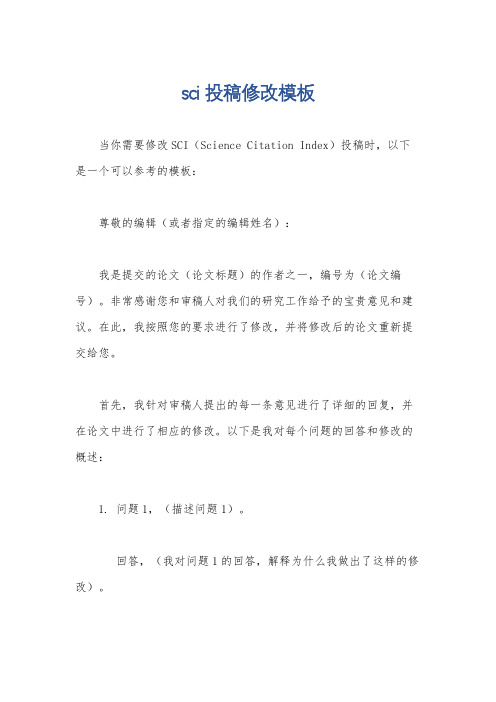
sci投稿修改模板当你需要修改SCI(Science Citation Index)投稿时,以下是一个可以参考的模板:尊敬的编辑(或者指定的编辑姓名):我是提交的论文(论文标题)的作者之一,编号为(论文编号)。
非常感谢您和审稿人对我们的研究工作给予的宝贵意见和建议。
在此,我按照您的要求进行了修改,并将修改后的论文重新提交给您。
首先,我针对审稿人提出的每一条意见进行了详细的回复,并在论文中进行了相应的修改。
以下是我对每个问题的回答和修改的概述:1. 问题1,(描述问题1)。
回答,(我对问题1的回答,解释为什么我做出了这样的修改)。
修改,(详细说明我对问题1的修改,包括具体的修改内容和位置)。
2. 问题2,(描述问题2)。
回答,(我对问题2的回答,解释为什么我做出了这样的修改)。
修改,(详细说明我对问题2的修改,包括具体的修改内容和位置)。
以此类推,我对每个问题进行了类似的回答和修改。
在修改过程中,我尽量保持了原文的逻辑和结构,并对问题进行了全面的修正和改进。
除了审稿人提出的问题,我还对论文的其他方面进行了进一步的修改和完善。
以下是我对论文的其他修改概述:1. 结构调整,我对论文的结构进行了调整,使其更加清晰和易读。
我重新组织了段落和章节,确保了论文的逻辑流畅性。
2. 文字表达,我对论文中的文字表达进行了精细的修改,修正了语法错误、句子结构和词汇选择。
我还对论文中的科技术语进行了统一和准确的使用。
3. 图表优化,我重新设计了论文中的图表,使其更加清晰易懂。
我修正了图表中的标注和单位,并调整了图表的尺寸和位置,以提高其可读性。
4. 文献引用,我对论文中的文献引用进行了仔细的检查和修正,确保其与正文内容的一致性和准确性。
我还添加了一些新的参考文献,以支持论文的观点和结论。
总的来说,我对论文进行了全面的修改和完善,以回应审稿人的意见和建议。
我相信这些修改能够进一步提升论文的质量和可读性,并使其更加适合发表在SCI期刊上。
200个sci收录杂志的写作模板

一、概述科研论文的发表是科研工作者进行学术交流、提升学术声誉、促进学术成果转化的重要途径。
而SCI收录的期刊则是国际上权威的学术期刊数据库,对发表的论文有着严格的要求和标准。
本文旨在整理和总结200个SCI收录杂志的写作模板,帮助科研工作者更好地撰写SCI 论文,提高发表的机会和质量。
二、SCI收录杂志写作模板分类1. 自然科学类(1)化学、物理、生物等自然科学类的期刊写作模板(2)研究方法和实验设计的论文写作模板2. 工程技术类(1)电子工程、机械工程、材料工程等工程技术类的期刊写作模板(2)工程实践和案例分析的论文写作模板3. 医学健康类(1)临床医学、基础医学、药学等医学健康类的期刊写作模板(2)流行病学调查和医学统计分析的论文写作模板4. 社会科学类(1)经济学、管理学、社会学等社会科学类的期刊写作模板(2)问卷调查和统计分析的论文写作模板5. 跨学科类(1)环境科学、食品科学、生态学等跨学科类的期刊写作模板(2)跨学科研究和综合分析的论文写作模板三、写作模板的基本要素1. 标题(1)标题要精炼准确,能够准确反映论文的主题和内容(2)避免使用过于晦涩或难以理解的词语,以便读者快速理解论文主题2. 摘要(1)摘要要简明扼要地介绍论文的研究内容、方法、结果和结论(2)摘要要遵循SCI收录期刊的要求,不超过250字,并且包括关键词3. 概述(1)概述要清晰地阐述论文的研究背景和意义,引出研究问题和目的(2)概述要对前人的研究成果进行梳理和评述,指出论文的创新点和贡献4. 方法(1)方法要详细描述研究的设计、实验和数据分析等内容(2)方法要能够让读者清晰地了解研究过程和可重复性5. 结果(1)结果要以数据和实验结果为主,以图表和文字相结合的方式呈现(2)结果要客观呈现研究成果,避免主观评价和夸大宣传6. 讨论(1)讨论要对结果进行解释和分析,指出研究的局限性和未来发展方向(2)讨论要提供科学的推理过程和逻辑,避免片面主观的理解7. 结论(1)结论要简明扼要地总结研究的主要发现和意义(2)结论要直接回答研究问题,措辞要准确客观四、写作模板的特殊要求1. 化学、物理、生物等自然科学类(1)实验方法的详细描述和数据的准确呈现是重点(2)科学表达和专业术语的正确使用是关键2. 工程技术类(1)工程设计和实践案例要体现实用性和先进性(2)专业知识和行业标准要做到精准有效的传达3. 医学健康类(1)临床试验和医疗实践的伦理规范和安全性是关键(2)医学统计分析和数据可信度要求非常高4. 社会科学类(1)问卷设计和调查分析的科学性和客观性是要求(2)社会问题的深入思考和多角度讨论是重点5. 跨学科类(1)综合研究和跨学科合作的整合性和创新性是关键(2)跨学科交叉思维和交流交流的全面性和系统性是要求五、写作模板的常见问题及解决方法1. 结构混乱(1)问题:论文结构不清晰,逻辑跳跃,读者难以理解(2)解决方法:在写作前进行详细的大纲规划和逻辑推理,确保结构合理有序2. 数据造假(1)问题:实验结果和数据不真实,严重影响论文的可信度(2)解决方法:遵守科研伦理,严格按照实验设计和数据分析的规范进行3. 文献引用错误(1)问题:文献引用不全面、不准确,论文的知识基础不够扎实(2)解决方法:认真查找相关文献,确保引用的准确性和权威性六、结语撰写SCI收录期刊的论文是每一个科研工作者的重要任务,也是展示学术水平和科研能力的重要途径。
SCI论文格式通用版
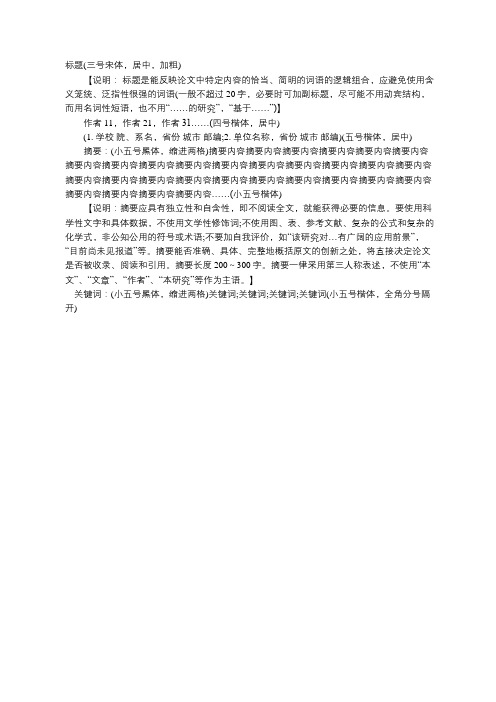
标题(三号宋体,居中,加粗)
【说明:标题是能反映论文中特定内容的恰当、简明的词语的逻辑组合,应避免使用含义笼统、泛指性很强的词语(一般不超过20字,必要时可加副标题,尽可能不用动宾结构,而用名词性短语,也不用“……的研究”,“基于……”)】
作者11,作者21,作者31……(四号楷体,居中)
(1. 学校院、系名,省份城市邮编;2. 单位名称,省份城市邮编)(五号楷体,居中)
摘要:(小五号黑体,缩进两格)摘要内容摘要内容摘要内容摘要内容摘要内容摘要内容摘要内容摘要内容摘要内容摘要内容摘要内容摘要内容摘要内容摘要内容摘要内容摘要内容摘要内容摘要内容摘要内容摘要内容摘要内容摘要内容摘要内容摘要内容摘要内容摘要内容摘要内容摘要内容摘要内容摘要内容……(小五号楷体)
【说明:摘要应具有独立性和自含性,即不阅读全文,就能获得必要的信息。
要使用科学性文字和具体数据,不使用文学性修饰词;不使用图、表、参考文献、复杂的公式和复杂的化学式,非公知公用的符号或术语;不要加自我评价,如“该研究对…有广阔的应用前景”,“目前尚未见报道”等。
摘要能否准确、具体、完整地概括原文的创新之处,将直接决定论文是否被收录、阅读和引用。
摘要长度200~300字。
摘要一律采用第三人称表述,不使用“本文”、“文章”、“作者”、“本研究”等作为主语。
】
关键词:(小五号黑体,缩进两格)关键词;关键词;关键词;关键词(小五号楷体,全角分号隔开)。
SCI论文写作框架及英文常用句型模板

SCI论文写作框架及英文常用句型模板1.标题:明确论文的主题和目标。
2.摘要:简要介绍论文的内容、研究方法和主要结论,通常在200-300个词之间。
3.引言:介绍研究的背景和意义,阐述相关文献的研究进展,明确研究的目的和研究问题。
4.材料与方法:详细描述研究所采用的方法和实验设计,包括样本收集、实验设置、数据分析等。
5.结果:以文字和图表的形式呈现研究的主要结果,客观、简明地总结实验数据。
6.讨论:对结果进行解释和分析,比较实验结果和现有文献,指出研究的局限性,提出建议和展望。
7.结论:简明扼要地总结研究的主要发现,回答引言中提出的研究问题,强调研究的重要性和价值。
英文常用句型模板:1.引言部分:- Introduce the background of the study: "In recent years, there has been a growing interest in..."- State the importance of the research: "This study aims to address the gap in knowledge by..."- Outline the objectives of the study: "This study seeks to investigate..., and to determine the impact of..."2.材料与方法部分:- Describe the research design: "A cross-sectional study design was employed..."- Explain the selection of participants: "A sample size of n=200 was determined based on..."- Discuss the data collection procedure: "Data was collected through structured interviews..."- Detail the statistical analysis: "Descriptive statistics and inferential analyses were conducted using..."3.结果部分:- Present the findings: "The results showed that there was a significant difference between..."- Discuss the key trends or patterns: "This finding suggests a positive correlation between X and Y."- Highlight any unexpected or interesting results: "Contrary to our hypothesis, the study found that..."4.讨论部分:- Interpret the findings: "These results suggest that X may be a key factor influencing Y."- Identify the limitations of the study: "One potential limitation of this study is the small sample size."- Provide suggestions for future research: "Further research is needed to explore the long-term effects of..."- Conclude the discussion: "In conclusion, this study contributes to the understanding of..."5.结论部分:- Summarize the main findings: "In summary, this study found that..."- Emphasize the significance of the research: "Thesefindings have important implications for..."- Discuss the potential applications of the results: "The findings of this study could be useful in..."以上是SCI论文写作的一般框架和常用句型模板,根据具体情况和论文要求,可以进行适当调整和修改。
SCI论文从投稿到接收的全过程的信件模板

SCI论文从投稿到接收的全过程的信件模板一、最初投稿,这一部分是必须的Cover letter,主要任务是介绍文章主要创新以及声明没有一稿多投稿件模板如下:Dear Editors:We would like to submit the enclosed manuscript entitled “Paper Title(论文题目)”, which we wish to be considered for publication in “Journal Name(杂志名称)”. No conflict of interest exits in the submission of this manuscript, and manuscript is approved by all authors for publication. I would like to declare on behalf of my co-authors that the work described was original research that has not been published previously, and not under consideration for publication elsewhere, in whole or in part. All the authors listed have approved the manuscript that is enclosed.In this work, we evaluated …… (简要介绍一下论文的创新性). I hope this paper is suitable for “Journal Name”.The following is a list of possible reviewers for your consideration:1) Name A E-mail: ××××@××××(Reviewer的名字及邮箱)2) Name B E-mail: ××××@××××(Reviewer的名字及邮箱)We deeply appreciate your consideration of our manuscript, and we look forward to receiving commen ts from the reviewers. If you have any queries, please don’t hesitate to contact me at the address below.Thank you and best regards.Yours sincerely,××××××(作者)Corresponding author: (通讯作者)Name: ×××E-mail: ××××@××××二、催稿信主要是询问稿件处理到声明步骤,首先要搞清楚,所投的杂志一般周期有多长,如果拖得时间太长,那这封信就有必要了稿件格式如下:Dear Prof. ×××:Sorry for disturbing you. I am not sure if it is the right time to contact you to inquire about the status of my submitted manuscript titled “Paper Title”. (ID: 文章稿号), although the status of “With Editor” ha s been lasting for more than two months, since submitted to journal three months ago. I am just wondering that my manuscript has been sent to reviewers or not?I would be greatly appreciated if you could spend some of your time check the status for us. I a m very pleased to hear from you on the reviewer’s comments.Thank you very much for your consideration.Best regards!Yours sincerely,××××××Corresponding author:Name: ×××E-mail: ××××@××××三、修改稿Cover letter,是论文修改之后,重新发给editor稿件格式如下:Dear Dr/ Prof..(写上负责你文章编辑的姓名,显得尊重,因为第一次的投稿不知道具体负责的编辑,只能用通用的Editors):On behalf of my co-authors, we thank you very much for giving us an opportunity to revise our manuscript, we appreciate editor and reviewers very much for their positive and constructive comments and sugg estions on our manuscript entitled “Paper Title”. (ID: 文章稿号).We have studied reviewer’s comments carefully and have made revision which marked in red in the paper. We have tried our best to revise our manuscript according to the comments. Attached please find the revised version, which we would like to submit for your kind consideration.We would like to express our great appreciation to you and reviewers for comments on our paper. Looking forward to hearing from you.Thank you and best regards.Yours sincerely,××××××Corresponding author:Name: ×××E-mail: ××××@××××四、修改稿回答审稿人的意见(最重要的部分)List of Responses稿件格式如下Dear Editors and Reviewers:Thank you for your letter and for the reviewers’ comments concerning our manuscript entitled “Paper Title” (ID: 文章稿号). Those comments are all valuable and very helpful for revising and improving our paper, as well as the important guiding significance to our researches. We have studied comments carefully and have made correction which we hope meet with approval. Revised portion are marked in red in the paper. The main corrections in the paper and the responds to the reviewer’s comments are as flowing:Responds to the reviewer’s comments:Reviewer #1:1. Response to comment: (……简要列出意见……)Response: ××××××2. Response to comment: (……简要列出意见……)Response: ××××××。
sci论文2篇

sci论文第一篇:气候变化对极地地区冰川的影响摘要:气候变化对极地地区的冰川有着重要影响。
本文通过对过去几十年来极地地区冰川变化的研究,分析了气候变化对冰川的影响机制,并预测了未来气候变化对冰川的可能影响。
结果表明,全球气温上升导致了冰川融化速度的加快,冰川面积的减少和冰川体积的减少。
另外,气候变化还会导致冰川消融水量的增加和冰川与海洋相互作用的变化。
未来气候变化对极地地区冰川的影响将更加显著,需要进一步研究和监测。
关键词:气候变化、极地地区、冰川、融化、海洋相互作用1. 引言极地地区是全球气候系统的重要组成部分,而冰川则是极地地区的重要特征之一。
气候变化对冰川的影响一直是地球科学研究的热点之一。
近年来,全球气温上升导致了冰川融化速度的加快和冰川面积的减少。
然而,目前对气候变化对极地地区冰川的影响机制和未来趋势仍存在一定的争议。
因此,本文旨在通过综合分析已有的研究成果,探讨气候变化对极地地区冰川的影响。
2. 气候变化对冰川的影响机制2.1 冰川融化速度的加快2.1.1 全球气温上升导致冰川融化2.1.2 大气环流变化对冰川融化的影响2.2 冰川面积的减少2.2.1 冰川消融和凝固的变化2.2.2 降水变化对冰川面积的影响2.3 冰川体积的减少2.3.1 冰川消融水量的增加2.3.2 冰川与海洋相互作用的变化3. 未来气候变化对冰川的影响预测3.1 冰川融化速度的加快3.2 冰川面积的进一步减少3.3 冰川体积的持续减少4. 结论气候变化对极地地区冰川的影响是不可忽视的。
全球气温上升导致了冰川融化速度的加快、冰川面积的减少和冰川体积的减少。
未来气候变化对冰川的影响将更加显著,需要进行进一步的研究和监测。
第二篇:全球水资源管理的挑战和对策摘要:全球水资源管理面临着许多挑战,包括水危机、水污染和水分配不均等问题。
本文通过对全球水资源管理现状的分析,总结了目前存在的问题,并提出了应对策略。
研究发现,全球水资源管理需要强化跨界合作、提高水资源利用效率和加强水环境保护。
sci rebutl 模板
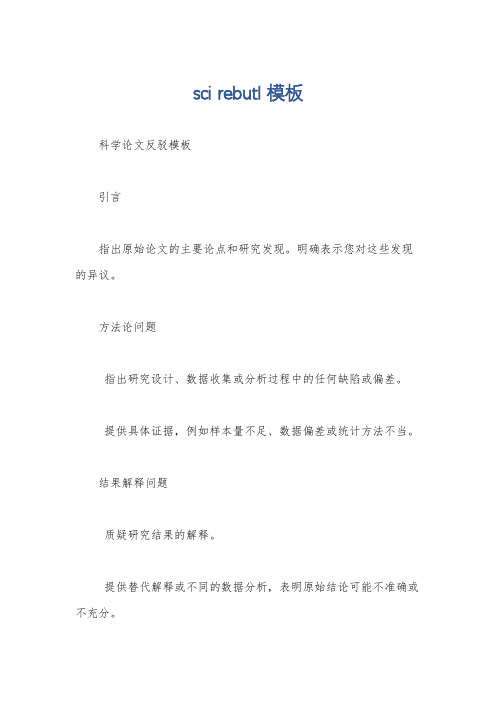
sci rebutl 模板科学论文反驳模板引言指出原始论文的主要论点和研究发现。
明确表示您对这些发现的异议。
方法论问题指出研究设计、数据收集或分析过程中的任何缺陷或偏差。
提供具体证据,例如样本量不足、数据偏差或统计方法不当。
结果解释问题质疑研究结果的解释。
提供替代解释或不同的数据分析,表明原始结论可能不准确或不充分。
突出任何与先前研究或已建立知识不一致的方面。
相关文献遗漏指出原始论文忽略或未充分考虑的相关研究或文献。
提供这些遗漏文献的摘要,说明它们如何挑战原始论点。
表明原始论文的发现可能受这些相关文献的影响。
理论基础不足指出原始论文中理论或概念基础的弱点。
提供替代理论或框架,更好地解释观察到的现象。
表明原始论文缺乏理论支持,削弱了其发现的有效性。
逻辑错误确定原始论文中任何逻辑错误或推理缺陷。
例如,指出任何非此即彼的论证、循环论证或稻草人谬论。
表明这些错误损害了论文的科学有效性。
数据质量问题评估原始论文中使用的数据的质量和可信度。
寻找任何错误、缺失或不一致的数据点。
提出关于数据收集或处理过程的担忧,可能影响了结果的可靠性。
结论总结您的反驳要点,阐明原始论文的主要缺陷和不足之处。
提供您对研究发现的修正或替代解释。
提出进一步的研究方向,以解决原始论文中提出的问题。
注意:在撰写反驳时,使用尊重和专业的方式至关重要。
避免人身攻击或主观意见。
提供明确的证据和支持性文献来支持您的论点。
清晰简洁地组织您的反驳,使读者易于理解和评估您的论点。
sci的论文格式

sci的论文格式sci的论文格式导语:SCI论文成功发表,其中SCI论文格式十分重要,一篇优秀的论文不仅内容上要有价值与创新,其排版格式也要符合规范,SCI论文主要包括3个部分,即前置部分、主题部分和附录部分,其排版先后顺序与具体格式要求如下,下面小编整理了sci的论文格式,欢迎参考借鉴!前置部分包括①题目(title);②作者(单位及/或个人姓名);③内容摘要(Summary);④关键词(keywords)。
主题部分包括⑤前言(introduction);⑥材料与方法(materi-alsandmethods);⑦结果(results);⑧讨论(disscussion);⑨结论(conclusion);⑩致谢(thanks)、参考文献(references)、完成论文或投稿日期、外文摘要。
附录部分包括图(chart)、表(table)、照片(photoshop)等。
格式并非一成不变,作者应根据文稿的内容、体裁及篇幅的长短撰写,切记不要硬套格式。
篇幅小的论文,可将前言、材料与方法两项合并,讨论与结论合并,并省去“内容摘要(Summary)”.有协作关系或得到有关单位个人支持帮助的,要在首页注脚处加一项“致谢(thanks)”.SCI论文字体、段落格式:纸张大小标准的8.5英寸x11英寸纸张大小。
页边距上下左右页边距都为1寸英。
字体12号字体大小。
Times Roman.但是图片使用无衬线字体,如Arial。
行距两倍行距。
对齐方式左对齐(右边距不相等)。
段落缩进5-7个空格。
句末句号后一个空格。
页码标题页开始,除图片页外每一页的右上角,离顶部0.5英寸处标上页码,右对齐。
标题页标题页通常是第一页。
在页码下一行,副标题左对齐,副标题要全部大写。
在副标题下,使用大写和小写表示以下内容,居中对齐。
文章标题你的名字你所属的机构信息。
段落标题一级标题使用大小写字母,并且居中。
二级标题使用大小写字母,左对齐。
SCI论文投稿信写作模板
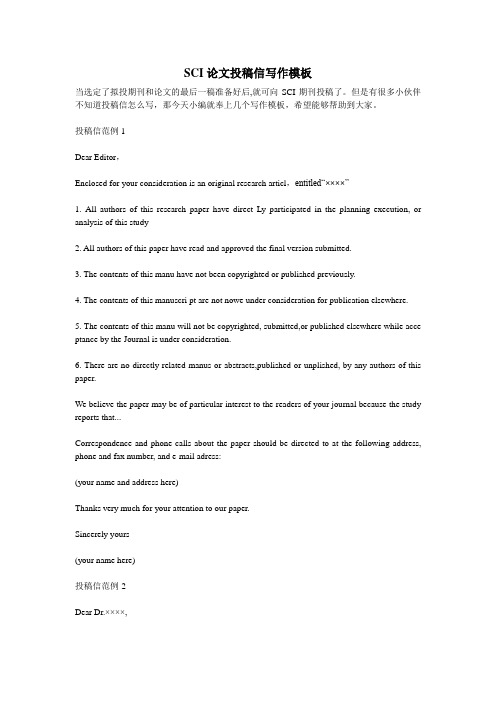
SCI论文投稿信写作模板当选定了拟投期刊和论文的最后一稿准备好后,就可向SCI期刊投稿了。
但是有很多小伙伴不知道投稿信怎么写,那今天小编就奉上几个写作模板,希望能够帮助到大家。
投稿信范例1Dear Editor,Enclosed for your consideration is an original research articl,entitled“××××”1. All authors of this research paper have direct Ly participated in the planning execution, or analysis of this study2. All authors of this paper have read and approved the final version submitted.3. The contents of this manu have not been copyrighted or published previously.4. The contents of this manuscri pt are not nowe under consideration for publication elsewhere.5. The contents of this manu will not be copyrighted, submitted,or published elsewhere while acce ptance by the Journal is under consideration.6. There are no directly related manus or abstracts,published or unplished, by any authors of this paper.We believe the paper may be of particular interest to the readers of your journal because the study reports that...Correspondence and phone calls about the paper should be directed to at the following address, phone and fax number, and e-mail adress:(your name and address here)Thanks very much for your attention to our paper.Sincerely yours(your name here)投稿信范例-2Dear Dr.××××,I would like to submit the attached manu,“××××”for considerati on for possible publication in the Research Articles section of SCIMy two nominees for associate editor are Dr. Smith and Dr.××××,Dr.Smith is well versed in the topic of the paper while Dr.×××× has used a methodology in his own research that is related to the methodology in the paper being submitted.Regarding the option of nominating up tofour reviewers, my nominees are:Name-1, Email address-1Name-2, Email address-2Name-3, Email address-3Name-4, Email address-4The nominees for associate editor and reviewers have no conf lict of in terest with any of the authors of the paper being submitted.This paper(or closely related research) has not been published or accepted for publication. It is not under consideration at another journal.No other papers using the same data set have been published. ( Note: If other papers using the data set have been published, please indicate differences between the submitted paper and the other published papers.)Sincerelyyour name and address hereOK,大家是不是觉得还是有点无从下手的感觉?小编也是非常理解大家的,毕竟,英语对于咱们中国人来说,可不是短期内就能up up up的。
sci的acknowledgement模板
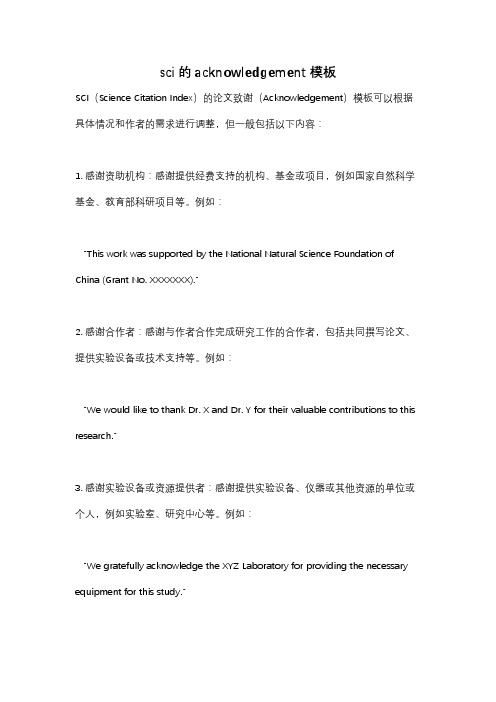
sci的acknowledgement模板SCI(Science Citation Index)的论文致谢(Acknowledgement)模板可以根据具体情况和作者的需求进行调整,但一般包括以下内容:1. 感谢资助机构:感谢提供经费支持的机构、基金或项目,例如国家自然科学基金、教育部科研项目等。
例如:"This work was supported by the National Natural Science Foundation of China (Grant No. XXXXXXX)."2. 感谢合作者:感谢与作者合作完成研究工作的合作者,包括共同撰写论文、提供实验设备或技术支持等。
例如:"We would like to thank Dr. X and Dr. Y for their valuable contributions to this research."3. 感谢实验设备或资源提供者:感谢提供实验设备、仪器或其他资源的单位或个人,例如实验室、研究中心等。
例如:"We gratefully acknowledge the XYZ Laboratory for providing the necessary equipment for this study."4. 感谢技术支持:感谢提供技术支持或实验操作指导的人员,例如实验室技术人员、研究助理等。
例如:"We would like to thank Mr. Z for his technical assistance during the experiments."5. 感谢学术交流:感谢与他人进行学术交流、讨论或提供有益建议的同行学者、专家或学术团体。
例如:"We are grateful to the participants of the XYZ conference for their valuable feedback and discussions."6. 其他感谢:如果有其他需要感谢的人或机构,可以在致谢部分进行说明。
SCI论文写作模板
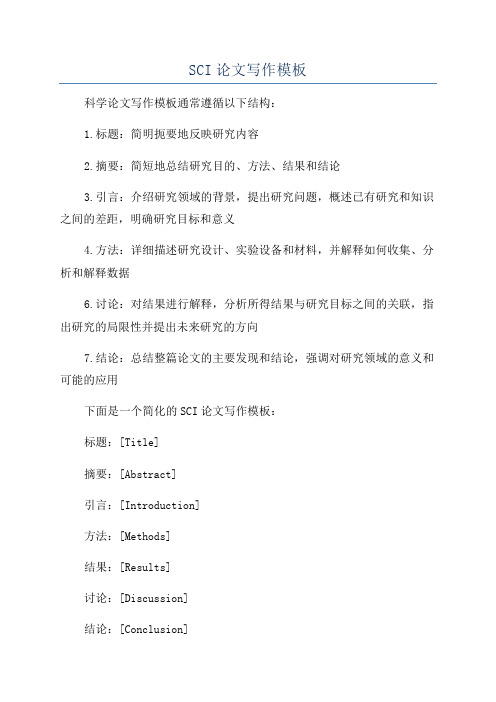
SCI论文写作模板
科学论文写作模板通常遵循以下结构:
1.标题:简明扼要地反映研究内容
2.摘要:简短地总结研究目的、方法、结果和结论
3.引言:介绍研究领域的背景,提出研究问题,概述已有研究和知识之间的差距,明确研究目标和意义
4.方法:详细描述研究设计、实验设备和材料,并解释如何收集、分析和解释数据
6.讨论:对结果进行解释,分析所得结果与研究目标之间的关联,指出研究的局限性并提出未来研究的方向
7.结论:总结整篇论文的主要发现和结论,强调对研究领域的意义和可能的应用
下面是一个简化的SCI论文写作模板:
标题:[Title]
摘要:[Abstract]
引言:[Introduction]
方法:[Methods]
结果:[Results]
讨论:[Discussion]
结论:[Conclusion]
请注意,根据不同的领域和期刊要求,模板的具体内容和组织结构可能会有所不同。
因此,在使用模板之前,请确保仔细阅读目标期刊的投稿指南,并根据其要求进行相应的调整。
此外,除了标题和摘要外,其他节的字数可能需要根据期刊的要求进行调整,通常要求在1200字以上。
- 1、下载文档前请自行甄别文档内容的完整性,平台不提供额外的编辑、内容补充、找答案等附加服务。
- 2、"仅部分预览"的文档,不可在线预览部分如存在完整性等问题,可反馈申请退款(可完整预览的文档不适用该条件!)。
- 3、如文档侵犯您的权益,请联系客服反馈,我们会尽快为您处理(人工客服工作时间:9:00-18:30)。
Running title: Li et al. On….An improved shuffled frog-leaping algorithm for knapsack problem Authors’ nameAffiliationCorrespondence autuor(通讯作者:): tel/fax XXX; e-mail: XXXAbstractShuffled frog-leaping algorithm (SFLA) has long been considered as new evolutionary algorithm of group evolution, and has a high computing performance and excellent ability for global search. Knapsack problem is a typical NP-complete problem. For the discrete search space, this paper presents the improved SFLA, and solves the knapsack problem by using the algorithm. Experimental results show the feasibility and effectiveness of this method.Keywords: shuffled frog-leaping algorithm; knapsack problem; optimization problem0 IntroductionKnapsack problem(KP) is a very typical NP-hard problem in computer science, which was first proposed and studied by Dantzing in the 1950s. There are many algorithms for solving the knapsack problem. Classical algorithms for KP are the branch and bound method (BABM), dynamic programming method(分支界定法和动态规划法), etc. However, most of such algorithms are over-reliance on the features of problem itself, the computational volume of the algorithm increases by exponentially, and the algorithm needs more searching time with the expansion of the problem. Intelligent optimization problem for solving NP are the ant colony algorithm, greedy algorithm, etc. Such algorithms do not depend on the characteristics of the problem itself, and have the strong global search ability. Related studies have shown that it can effectively improve the ability to search for the optimal solution by combining the intelligent optimization algorithm with the local heuristic searching algorithm.Shuffled frog-leaping algorithm is a new intelligent optimization algorithm, it combines the advantages of meme algorithm based on genetic evolution and particle swarm algorithm based on group behavior. It has the following characteristics: simple in concept, few parameters, the calculation speed, global optimization ability, easy to implement, etc. and has been effectively used in practical engineering problems, such as resource allocation, job shop process arrangements, traveling salesman problem, 0/1 knapsack problem, etc. However, the basic leapfrog algorithm is easy to blend into local optimum, and thus this paper improved the shuffled frog-leaping algorithm to solve combinatorial optimization problems such as knapsack problem. Experimental results show that the algorithm iseffective in solving such problems.1 The mathematical model of knapsack problemKnapsack problem is a NP-complete problem about combinatorial optimization, which is usually divided into 0/1 knapsack problem, complete knapsack problem, multiple knapsack problem, mixed knapsack problem, the latter three kinds can be transformed into the first, therefore, the paper only discussed the 0/1 knapsack problem. The mathematical model of 0/1 knapsack problem can be described as:00max (x 10,1,2,...,)n i i i n i i i i x v x w C or i n ==⎧⎪⎪⎨⎪≤==⎪⎩∑∑ where: n is the number of objects; w i is the weight of the i th object(I = 1, 2…n ); v i is the value of the i th object; x i is the choice status of the i th object; when the i th object is selected into knapsack, defining variable x i = 1,otherwise x i = 0; C is the maximum capacity of knapsack.2 The basic shuffled frog-leaping algorithmIt generates P frogs randomly, each frog represents a solution of the problem, denoted by U i , which is seen as the initial population. Calculating the fitness of all the frogs in the population, and arranging the frog according to the descending of fitness. Then dividing the frogs of the entire population into m sub-group of, each sub-group contains n frogs, so P =m*n. Allocation method: in accordance with the principle of equal remainder. That is, by order of the scheduled, the 1, 2, ..., n frogs were assigned to the 1,2, ...., N sub-groupsseparately, the n+1 frog was assigned to the first sub-group, and so on, until all the frogs were allocated.For each sub-group, setting U B is the solution having the best fitness, U W is the solution having the worst fitness, U g is the solution having the best fitness in the global groups. Then, searching according to the local depth within each sub-group, and updating the local optimal solution, updating strategy is:{}{})min int((),,0max max int(()),,0max rand U U S U U B W B W rand U U S U U B W B W S --≥---≤⎧⎪=⎨⎪⎩ q w U U S =+where, S is the adjustment vector of individual frog, S max is the largest step size that is allowed to change by the frog individual. Rand is a random number between 0 and 1.3 The improved shuffled frog-leaping algorithm for KPA frog is on behalf of a solution, which is expressed by the choice status vector of object, then frog U = ( x 1, x 2, …, x n ), where, x i is the choice status of the i-th object; when the i-th object is selected into knapsack, defining variable x i = 1,otherwise x i = 0; f (i), the fitnessfunction of individual frog can be defined as:3.1 The local update strategy of frogThe purpose of implementing the local search in the frog sub-group is to search the local optimal solution in different search directions, after searching and iterating a certain numberof iterations, making the local optimum in sub-group gradually tend to the global optimum individual.Definition 1 Giving a frog’s status vector U, the switching sequence C(i,j) is defined:where, U i said the state of object i becomes from the selected to the cancel state, or in turn; U i= U j, object i and object j exchange places, that object i and object j are selected or deselected at the same time. U i≠U j, object i is selected or canceled, or in turn. Then the new vector of switching operation is:Definition 2 Selecting any two vectors U i and U j of frog from the group, D, the distance from U i to U j is all exchange sequences that U i is adjusted to U j.where, m is the number of adjusting.Based on the above definition, the update strategy of the individual frog is defined as follows:where, l is the number of switching sequence D(U B,U W) for updating U W; l max is the maximum number of switching sequence allowed to be selected; s is the switching sequence required for updating U W.3.2 The global information exchange strategyDuring the execution of the basic shuffled frog-leaping algorithm, the operation of updating the feasible solution was is executed repeatedly, it is usually to meet the situation that updating fail, the basic shuffled frog-leaping algorithm updates the feasible solution randomly, but the random method often falls into local optimum or reduces the rate of convergence of the algorithm.Obviously, the key that overcoming the shortcomings of basic SFLA in evolution is: it is necessary to keep the impact of local and global best information on the frog jump, but also pay attention to the exchange of information between individual frogs. In this paper, first two jumping methods in basic SFLA are improved as follows:P n= P X + r1*(P g-Xp1 (t)) +r2*(P W-Xp2 (t)) ( 5)P n= P b + r3*(P g-Xp3 (t)) ( 6)Where, Xp1(t),Xp2(t),Xp3(t) are any three different individuals which are different from X. Meanwhile, removing the sorting operation according to the fitness value of frog individual from basic SFLA, and appropriately limiting the third frog jump. Thus, we get anefficient modified SFLA basing on the improvements of above. In the modified algorithm, the frog individual in the subgroup generates a new individual ( the first jump)by using formula (5),if the new individual is better than its parent entity then replacing the parent individual. otherwise re-generating a new individual (the frog jump again)by using (6).If better than the parent ,then replacing it. or when r4 ≤ FS (the pre-vector, its components are 0.2≤ FSi≤ 0.4),generating a new individual (the third frog jump ) randomly and replacing parent entity.The new update strategy will enhance the diversity of population and the search through of the worst individual in the iterative process, which can ensure communities’evolving continually, help improving the convergence speed and avoid falling into local optimum, and then expect algorithm both can converge to the nearby of optimal solution quickly and can approximate accuracy, improved the performance of the shuffled frog-leaping algorithm.4 Simulation experimentTwo classical 0/1 knapsack problem instances were used in the paper, example 1 was taken from the literature [11], example 2 was taken from the literature [12]. The comparison algorithm used in the paper was branch and bound method for 0/1 knapsack problem. Under the same experimental conditions, two instances of simulation experiments were conducted 20 times, the average statistical results were shown in Table 1 and Table 2.5 ConclusionThe shuffled frog-leaping algorithm is a kind of search algorithm with random intelligence and global search capability, this paper improved shuffled frog-leaping algorithm and solved the 0/1 knapsack problem by using the algorithm. Experiments show that the improved algorithm has better feasibility and effectiveness in solving 0/1 knapsack problem.AcknowledgementsThis work was supported by XXX(基金号). Our special thanks are due to Prof. XXX (name), XXX (affiliation), for his helpful discussion with preparing the manuscript.References:[7] Eusuff MM, Lansey KE. Optimization of water distribution network design using theshuffled frog leaping algorithm[J]. Water Resource Planning and Management, 2003, 129(3): 210~225[8] Ying-hai LI, Jian-zhong ZHOU, Jun-jie YANG. An improved shuffled frog-leapingalgorithm based on the selection strategy of threshold[J].Computer Engineering and Applications, 2007, 43(35): 19~21[9] Xue-hui LUO, YANG Ye, LI Xia. Improved shuffled frog-leaping algorithm for TSP[J].Journal of Communication, 2009, 30(7): 130~135[10] Zong-yi XUAN, Cui-jun ZHANG. Solving the KP based on shuffled frog-leapingalgorithm[J].Science Technology and Engineering,2009,9(15): 4363~4365[11] Zhao-yang, Shan-juan. A binary shuffled frog-leaping algorithm for 0/1 KP[11] Yi-chao HE.Greedy genetic algorithm and its application for KP[J].ComputerEngineering and Design,2007,28(11): 19~22[12] Ze-hui WU. Algorithm Design and Analysis[M]. Beijing: Higher EducationPress,1993:251~252。
